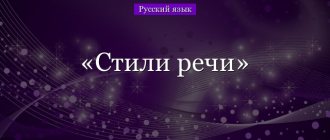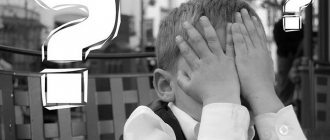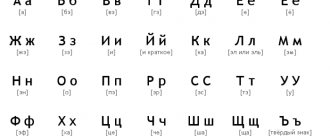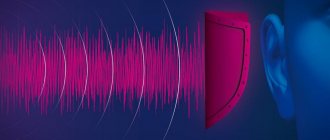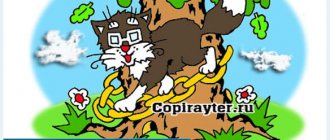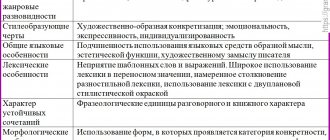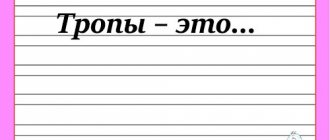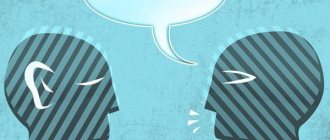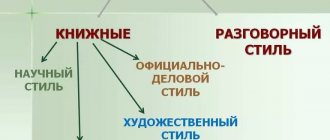Speech styles are its varieties that are used in one or another sphere of public life: in everyday communication, in official business relations, in the media, in the field of science, in fiction.
The type of speech is the way of presentation, the construction of words and sentences in a logical order. Depending on the content of the text, the following types of speech are distinguished: narration, description, reasoning.
Depending on the scope of use, the following functional styles of speech are distinguished: colloquial, official business, journalistic, scientific, artistic .
Conversational style
The conversational style is used in everyday communication between people in order to share their thoughts, feelings, information, express their motives, etc. The conversational style functions in everyday life: at home, on the street, in a store, at work between employees, in an informal setting.
The main function of the conversational style is the communication function, providing everyday, everyday connections between people.
Characteristic features of the conversational style: the predominance of oral speech, informality, ease, specificity, simplicity, emotionality, the use of colloquial vocabulary, often with a colloquial flavor.
Genres (varieties) of conversational style depending on the communication situation: dialogue (conversation), telephone conversation, letter, note. Recently, the conversational style has been enriched by the genre of correspondence on the Internet, by mobile phone (sms).
The usual form of implementation of the conversational style is dialogue;
this style is used exclusively in spoken language. There is no preliminary selection of language material.
Reasoning
Reasoning texts are quite complex in their design. First of all, you should understand why you need to write them in the first place.
The main task of such texts is to convey to the reader some idea, the author’s views on a particular problem. Therefore, he must initially formulate a thesis - the main idea of his text, what will be discussed further, then argue it in detail, citing evidence. At the end, the author must draw conclusions and consolidate everything that was said earlier.
Reasoning texts can be divided into three basic categories:
- Proof.
- Explanations.
- Reflections.
However, the main task of reasoning is to convince the reader of something, to show him a different point of view. Reasoning is characterized by enumeration, repetition and clarification.
Examples of text with reasoning
As an example of a text-reasoning, one can cite the philosophical notes of Lev Nikolaevich Tolstoy.
The totality of causes of phenomena is inaccessible to the human mind. But the need to find reasons is embedded in the human soul. And the human mind, without delving into the innumerability and complexity of the conditions of phenomena, of which each separately can be represented as a cause, grabs the first, most understandable convergence and says: this is the cause. In historical events (where the object of observation is the actions of people), the most primitive convergence seems to be the will of the gods, then the will of those people who stand in the most prominent historical place - historical heroes.
Formal business style
The official business style is used in an official setting: in the areas of office work, legislation, and diplomacy.
The main functions of the official business style are to regulate relations between society and the state, between states, between citizens in their labor and social activities, in the sphere of property and legal relations; informative function.
Characteristic features of the official business style: the predominance of the written form, formality, regulation, standardization of texts, accuracy, specificity, rigor, impersonality, unemotionality, the predominance of official business vocabulary. The official business style is characterized by the presence of speech cliches, a generally accepted form of presentation, a standard presentation of the material, the widespread use of terminology and nomenclature names, the presence of complex unabridged words, abbreviations, verbal nouns, and the predominance of direct word order.
Genres of official business style depending on the scope of operation: laws, charters, decrees, orders, decrees, resolutions, notes, communiqués, announcements, certificates, reports, questionnaires, applications, powers of attorney, autobiographies, resumes, characteristics, acts, protocols, instructions , contracts, agreements, etc.
The type of speech in the official business style is predominantly reasoning.
The type of speech is most often a monologue.
Journalistic style
The sphere of use of the journalistic style is public life, politics, economics, culture. This style is addressed to listeners and readers - this is evidenced by the origin of its name (from the Latin publicus - public).
The main function is to discuss pressing social and public issues in order to attract public opinion to them, influence people, encouraging them to take certain actions. Areas of operation : the media, public speeches of politicians, speeches of lawyers in court, speeches at meetings, reports, discussions.
Characteristic features of the style: relevance, timeliness, efficiency, imagery, expressiveness, emotionality, evaluativeness, clarity, logic, information richness, use of means of other styles (especially artistic and scientific); accessibility (understandability for a wide audience), bias, appealing pathos.
Linguistic features : widespread use of socio-political vocabulary; stereotypical, stable phrases and expressions; combining book and colloquial vocabulary; rhetorical devices (questions, exclamations, appeals), emotional coloring of speech.
Genres of journalism : interview, report, note, article, essay, feuilleton, report, discussion, public speech (entertaining, informational, propaganda), etc.
The type of speech is predominantly reasoning.
Form of speech - written or prepared oral.
Type of speech - monologue, dialogue, polylogue.
Description. Structure and Features
As was said earlier and as is clear from the very name of this type of speech, a description was created in order to describe something, to give the most complete characteristics. It doesn’t matter what exactly: an object, a phenomenon or an event. Typically, this genre is used in fiction to immerse readers as deeply as possible into the world that the author creates.
Authors of commercial texts do not shy away from descriptions either. The brighter, more colorful and more profitable a product is described, the greater the likelihood of demand for it.
Descriptions can also be found in scientific literature. But if in works of art they will be more vivid and imaginative, then in textbooks and monographs they will be more strict, usually in the form of characteristics. The description can be presented in completely different forms.
You can describe different objects: both specific objects and a picture or atmosphere in general. Descriptions of people's appearance and verbal portraits are very common. The authors also periodically evaluate the object being described.
Types of description include:
- description of a person’s appearance (or portrait);
- description of the human condition;
- description of a person's character;
- description of the environment (most often nature);
- description of the area (city, village, locality);
- description of the item.
This type of speech is rich in adjectives, adverbs and various means of artistic expression: epithets, metaphors, hyperboles or litotes. Also in descriptions there are often rows of homogeneous members of a sentence. The verbs in the descriptions are minimal, as are any actions in principle. If they exist, they are mainly in the present tense and in an imperfect form. Sometimes they are introduced to give the reader a more complete picture, but they try not to overuse it.
Examples of text with description
To understand this type of speech even better, it is worth considering specific examples.
Portrait:
She was short, but at the same time very slender, feminine and charming. Her hair was light brown, her eyes were blue, and her lips were slightly swollen. Overall, Anna looked very pretty.
Description of nature:
Rowan is elegant from spring to autumn. Every day the berries on it become more orange and brighter. Until, finally, rowan bonfires flare up on the forest edge. They will burn for a long time, illuminating the forest with their cold flame, until noisy and nimble bands of thrushes swoop down on them for a merry feast.
Scientific style
The scientific style is used in the field of scientific activity in a formal setting: at lectures, seminars, conferences, symposia, colloquiums; in scientific literature.
The main function is to exchange scientific information, report scientific information, etc.
Characteristic features : formality, preparedness of speech, a combination of written and oral forms, objectivity, logic, evidence, accuracy (unambiguity), generalization, the use of special, professional vocabulary, terms, complex syntactic structures, links to sources, quotes.
Genres : scientific monograph, scientific article, scientific report, theses, dissertation, lecture, review, report, textbook, popular science work, discussion, etc.
Main substyles of scientific style
| Varieties | Actually scientific | Scientific and educational | Popular science |
| Target | Identification and description of new facts, patterns, discoveries | Teach, describe the facts necessary to master knowledge | Give an idea of science and interest the reader |
| Destination | Scientist, specialist in a given field of science | Student, future specialist | Any person interested in one or another science |
Tips for beginners
Well, is the knowledge more or less sorted out? Don’t worry, the rest will come with practice, and a rare customer will be interested in your knowledge of aspects of linguistics. The main thing is efficiency, expressed in increasing the site’s rankings and increasing conversion. And for dessert - a couple of tips for beginners:
- Ask for a sample. Ideally, the customer fills out the brief and gives specific instructions in what style the text should be written. But this is not always the case, so sometimes you have to play a guessing game. Unfortunately, we are not endowed with the gift of telepathy, so getting it right the first time can be problematic. Therefore, immediately ask the customer to provide a link to a competitive resource with a similar topic, where, in his opinion, good texts are posted. All! And don’t get smart by throwing around terminology - do the same, but even better.
- Don't forget to clean your texts. Sometimes you just want to pour more water, which is inherent in lively conversational speech, or to drill in hated words like “given” or “is.” Try to get rid of this habit by mercilessly clearing your texts of verbal garbage. You shouldn’t squeeze the content dry, as many infostyle apologists preach, but even the works of classics of world literature need editing, not to mention articles by modest writers.
- Develop your own style. Yes, yes, this is exactly the author’s style that I spoke about just above, which distinguishes texts created by a true professional. They are interesting, bright, lively, and not at the expense of information content and the implementation of the main goals. There’s no point in flaunting your virtuoso command of words, because the reader should also receive information that can easily be lost behind all sorts of “beauties.” In the end, he will go to the library for high literature. However, any author should be able to vividly talk about quite complex things, because this is part of professional skill.
While writing this article, I adhered to a predominantly conversational style with scientific and journalistic elements. If you noticed this, then my efforts were not in vain!
Art style
The artistic style is the richest style of speech, because it absorbs all the others. It most clearly reflects the national language in all its diversity and richness - it becomes a phenomenon of art, a means of creating artistic imagery.
The main function is aesthetic. The artistic style, using a variety of linguistic means, creates images that evoke an emotional response in the reader’s soul, deliver aesthetic pleasure, and force empathy. Other functions: reflection, transformation of all aspects of reality, using them as an object of creativity; impact on the reader.
Varieties of artistic style: the style of a literary movement, literary school, type of literature (epic, lyric, drama), individual style of writers, poets.
Characteristic features : imagery, aesthetics, individuality, the use of stylistically colored vocabulary, visual and expressive means (tropes, figures of speech, sound writing, color painting), using means of other styles, especially colloquial.
Main genres (by type of literature): epic - novel, story, short story, sketch, short story, poem, fable; lyric - poem, poem, elegy, song, message; drama - tragedy, drama, comedy, melodrama, vaudeville, tragicomedy.
What have we learned?
There are several functional styles in the Russian language. Each of them has its own goals and objectives, genres and addressees, goals and linguistic means. In order not to be mistaken in determining the style, it is necessary to take into account all these factors. The style of fiction stands apart, in which many styles are combined.
Previous
Russian languageWays of forming words - examples (grade 7, Russian)
Next
Russian languageSuffix - spelling in Russian in the table (Russian language, grade 7)
Functional and semantic types of speech
Speech types are often mistakenly confused with speech styles. However, a functional speech style is a set of speech elements (words and ways of constructing sentences that are special for each speech style).
And the type of speech is the way of presentation, the construction of words and sentences in a logical order. Depending on the content of the text, the following types of speech are distinguished: narration, description, reasoning.
Let's consider the features of each type of speech.
A narrative is a story about an event that occurs in a certain period of time. The actions reflected in the event are sequential and logically related to each other. The narration can come from both the third person and the first, and it is characterized by such elements as the beginning (the beginning of the event), the development of the action and the denouement (the outcome of the event being described).
Since the narrative is an event text, its speech feature is a large number of verbs and a chain development of action. The text answers the questions “what? Where? When?" - What's happened? where and with whom did it happen? when did it happen?
The narration can be pictorial (the emphasis is on changing images that “show” the event) and informative (the text not only talks about the event, but also explains it and includes interesting facts).
Example of a narrative text:
“At night a strong wind rose and it started to rain. It quietly drummed on the roof and flowed down the glass, turning the world outside the window into a blur. Streams of water washed away dust from trees and sidewalks, gurgled in gutters, and cooled the city scorching from the summer heat. And those who were not sleeping opened the windows, inhaled the damp coolness and exposed their faces to the icy drops. The city had been waiting for rain for two months, and now that it came, people smiled silently, blessing the crying sky...”
An example text - a visual narrative - answers the following questions:
- What's happened? – it started to rain in the city;
- where and with whom did it happen? – city residents waited for the rain;
- when did it happen? - It started to rain in the summer.
Description is a verbal image of an object, phenomenon, event. The description lists and reveals the main features of the selected item. The goal is to present the reader of the text with an image that is easy to imagine in color. The unity of time and place of manifestation of signs is important.
The description text consists of the following parts:
- general characteristics of the item, general impression;
- signs, details;
- overall assessment of the subject.
For example, the description can be portrait, landscape; the object of writing can be anything - a person, his emotional state, an animal, a plant, a place (city, hotel house, park, village), and the weather. Speech feature – predominance of nouns, adjectives, adverbs, minimum action and static text.
Descriptive text answers the questions “which one?” which?" (what object is being described? what does it look like? what are its qualities and properties?).
Example of descriptive text:
“It rained for the third day. Gray, small and harmful. Unpredictable, like a low gray sky. Endless. Endless. He restlessly knocked on the windows and quietly rustled on the roof. Sullen and carefree. Annoying. Bored.”
Sample text answers descriptive questions:
- what object is being described? - rain;
- what is the subject? – gray, small, harmful, unpredictable, endless, etc.
Reasoning is the development and confirmation of thought, the explanation of a phenomenon (properties of an object) and the expression of one’s own opinion. Reasoning answers the questions “why?” For what?".
The reasoning consists of the following parts:
- thesis - an idea that needs to be proven;
- justification of the thesis, supporting argumentation with examples, evidence;
- summary – results, conclusions.
The text of the argument is aimed at convincing, explaining, proving. Reasoning is characterized by the active use of rhetorical questions and introductory words - connectives: firstly... secondly... thirdly... therefore (thus accordingly); meanwhile, because, so.
The reasoning is as follows:
- reasoning-proof (why is this and not otherwise? What follows from this?);
- reasoning-explanation (what is it? where did it come from? Why is the subject exactly like that?);
- reasoning-reflection (what to do? To be or not to be? What to do?).
An example of a reasoning text:
“So, the night will pass, and the rain will stop making noise, the thunder will die down. So, what is next? Again – the sweltering heat of a stuffy summer? Again – hot asphalt? Again - a city choking in dust? Or will the weather have mercy on tired city dwellers and give at least a week of coolness? Since the weather forecasters' predictions are vague and vague, we can only wait and watch.”
An example text – reasoning-reflection – answers the following questions:
- Why? – because the rain will stop and the heat that everyone is tired of will return;
- For what? - to imagine what to expect from the capricious nature.
Types of speech are methods of presentation that solve the following author’s tasks:
- narration – dynamically reflects reality, tells about its events; narration is a clip, a movie, a change of frames;
- description – depicts a static reality, studies the object of interest from all sides; the description is a photograph, a frozen frame;
- reasoning – looks for cause-and-effect relationships between events and phenomena, expresses the author’s opinion, “because...”; This is a diagram with blocks of theses and evidence and arrows - logical questions.
Reminder: Do not confuse functional speech styles with speech types.
After all, for example, a newspaper article in a journalistic style of speech can be narrative (a report from the scene), and descriptive (a note about a missing person; an advertisement for a new building), and reasoning (an analytical article).
Narration
A narrative is a type of text that describes events in a specific sequence.
The purpose of narration in the text is to convey a series of events, information about the sequential development of action. The expanded narrative text is built according to the following scheme:
- the plot is the event from which it all began, the reason why the chain of interconnected actions unfolded further;
- development with or without culmination: listing the main stages, the relationship of key points;
- denouement is the last link in the chain of events.
Example text - narrative
At ten o'clock in the morning both armies met with a rifle shot, and fire opened along the entire line. The troops then rushed hand to hand; the first clash occurred on the left flank of the Russian infantry, the right flank of the Swedish infantry, inspired by the presence of the king, rushed at the Russians and overthrew the battalion of the Novgorod regiment; there was a gap in our line. Peter the Great, noticing the danger, took the second line battalion and personally led it against the enemy.
The dynamic nature of the presentation, change of actions, sequential logic of presentation (chronology) are the features of narrative texts. This effect is achieved through the use of the following grammatical means:
- simple or compound verbal predicates;
- the type and tense of verbs correspond to the logic of the narrative;
- homogeneous predicates;
- direct word order in a sentence.
